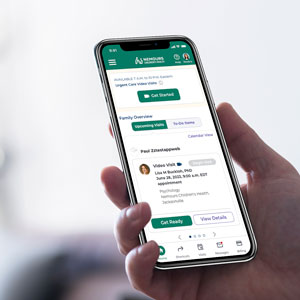Your Child's Neuroscience Center Visit
What to Expect When You Come Here
We you come to our pediatric Neuroscience Center we try to make your visit as seamless as possible. We’ve designed many of our clinics so that you can meet with multiple specialists on the same day.
We pay close attention to the details that affect how families and kids feel when they’re here. Our spaces are bright, comfortable and include play whenever possible.
If you’re coming for the first time, here’s what to expect.
Your Child’s First Neurology Appointment

Families see neurologists for a whole range of conditions. Usually, at your first visit, we:
- Take a medical history.
- Have you and/or your child answer questions about symptoms.
- Do a medical exam.
- Learn about your child’s goals, interests and needs.
- Discuss treatment.
Depending on your visit, you may need certain tests first. That way, we can go over the results with you. Other times, we may order tests after your first visit, when we learn more about your child’s symptoms.
When you make your appointment, we’ll review that with you.
If you’ve had imaging or other tests at other hospitals, we can help you have those records sent to Nemours Children's.
What to Expect: Common Neurology Tests and Procedures
If your child is coming in for a test or procedure, they may feel better knowing what to expect.
We use EEGs to find problems related to the brain’s electrical activity. An EEG study records brain wave patterns and helps us diagnose what type of epilepsy your child has.
An EEG isn’t painful. But it can be stressful for kids. It’s better if kids sleep during parts of the recording. You may get instructions to sleep-deprive your child the night before the study, to make them extra sleepy during the EEG.
The test usually takes about an hour.
Here’s What Happens
- Your child will lie on a bed or sit in a chair.
- An EEG technologist will use a tape measure to measure your child’s head. This helps us know where to place the electrodes, which measure the brain’s electrical signals. We use a paste to attach the electrodes and it doesn’t hurt.
- During the test, the technologist will talk your child through some tasks, like blowing on a pinwheel. This helps us get more information. We’ll know your child’s medical history and will make sure they stay safe.
Learn more about EEGs from NemoursKidsHealth.
Some kids will need to spend one or more nights in our Epilepsy Monitoring Unit (EMU). This is so that we can get a continuous EEG reading. This means it records activity the entire time, until we turn it off.
An EMU stay helps us better diagnose some types of epilepsy and gives us important information to help guide your child’s epilepsy care.
Here’s What Happens:
- After you get settled in, an EEG technologist will attach electrodes to different locations on the scalp using a paste. These electrodes measure the brain’s electrical signals.
- You’ll be in the room with your child the entire hospital stay. We do everything we can to make you and your child comfortable. A Child Life specialist will stop by to offer different age-appropriate activities for your child.
- We’ll send you back home once we have enough information from the study, usually during late morning on day of discharge.
An EMG is a way to measure how muscles and nerves respond to electrical activity. We use an EMG to help diagnose conditions that cause muscle weakness, like muscular dystrophy and other muscle and/or nerve problems.
The EMG can be uncomfortable, but different children respond differently. For some kids, it may be better to sleep during the test. Our Child Life specialists also help distract kids during this procedure.
Here's What Happens
- Your child will lie on a table, and a doctor will attach small stickers (electrodes) to their arms and legs.
- First, the doctor will send a small electrical impulse through the stickers. This usually feels like a buzz.
- Next, the doctor will put a small needle electrode into the muscle to measure electrical activity. This can feel like a small injection.
Learn more about EMG from NemoursKidsHealth.
A CT scan is a type of imaging test that gives doctors more detailed images than an X-ray. For a head CT scan, we use a special X-ray machine to take pictures of the brain, skull, and sinuses, as well as blood vessels in the head.
The test is painless and nothing touches your child’s body.
Here’s What Happens
- Your child will lie on a table, usually with a pillow or soft brace to help hold their head and neck in place.
- A donut-shaped machine circles the head, taking pictures from different angles.
- The test can take 30 minutes or more. If you think your child needs sedation to stay still, please let us know before your appointment. Sedation requires special fasting instructions and recovery time.
Learn More From Nemours KidsHealth
Here's What Happens
- Your child will lay on a sliding table that moves into the tunnel.
- Sometimes sedation is needed to keep kids still.
- A contrast solution might be needed for better visibility.
- The machine makes repetitive, loud noises during scanning.
- The test could take 30 minutes to an hour.
- Results are interpreted by a radiologist and discussed with the doctor.
Getting an MRI
The more your child knows, the more relaxed they'll be. See what to expect with an MRI. If appropriate for their age, share the video with them.
A PET/MRI scan combines two types of imaging in one session. These images help us learn a lot about seizures or tumors in the brain, so we can figure out how to best treat them. If we’re considering epilepsy surgery for your child, this is one of the tests we may order.
A PET/MRI a multistep process that usually takes 2-3 hours. We sedate babies and young kids.
Here’s What Happens
- Children with epilepsy have an EEG before the PET scan.
- For the PET scan, we inject a small amount of a radioactive element (called a tracer), through an IV. Your child will rest quietly for about 45 minutes while the tracer settles.
- During the scan, you child will lie flat on a table that moves in and out of a donut-shaped MRI machine. Your child’s head will rest comfortably inside of a plastic coil.
- The sedation usually wears off within 1-2 hours and your child shouldn’t feel any effects from the tracer.
Learn more about PET/MRI from NemoursKidsHealth.
A sleep study helps doctors diagnose sleep problems. This is an overnight test that records different body functions while your child sleeps. During a sleep study, your child will stay overnight in a private, kid-friendly room. You’ll be able to stay with them in the room.
Here’s What Happens
- Try to have your child get a normal night’s sleep the night before the study (but don’t nap the day of).
- Once here, the sleep technician will put sensors on your child in different areas, like the head, chin, legs, and around the eyes. We’ll also put an elastic belt around your child’s chest to measure breathing.
- We also record sounds and may use a camera to record their sleep as well.
- In the morning, we’ll remove all the sensors. It will be over in time for your child to go to school.


